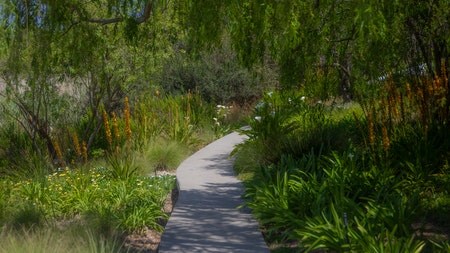Covering bare soil in your garden with groundcovers is an attractive way to help retain moisture for the bigger plants like shrubs, trees and flowers. It also prevents weeds from growing between plants so that you can spend less time weeding and more time on other rewarding garden tasks - or just chilling.
These undemanding plants are also a great way to help reverse climate change.
Climate change
Carbon dioxide gas forms a blanket surrounding the Earth, preventing heat from escaping out of the atmosphere. As the amount of carbon dioxide increases, the blanket gets progressively thicker. As a result, even more heat is trapped, creating a 'greenhouse effect' resulting in global warming.
The solution is to slow down - and possibly reverse – the creation of atmospheric carbon dioxide and increase the amount of carbon stored in the soil, plants, and oceans worldwide.
The process of trapping carbon in carbon sinks like forests, soils and various geological formations is known as carbon sequestration.
Plants trap carbon in their cells, increasing the amount of organic matter in the form of carbohydrates, which then return to the soil. However, when bare soil is exposed to air, sun and wind, the opposite takes place. Organic matter in the soil breaks down, and carbon dioxide is released into the atmosphere.
Covering up
An attractive and relatively inexpensive way of boosting carbon sequestration is to plant groundcovers between larger plants and under trees where it is sometimes difficult for grass to grow.
Another method is to cover the bare soil with a thick layer of organic mulch such as bark, wood chips, pine needles, peach pips or half-decomposed compost.
Water-wise
There are many pretty water-wise groundcovers to choose from. Many of the indigenous species grow in the wild, so they are hardy and need little extra care. This makes them ideal for gardeners with little time on their hands.
If you plant them now in autumn, they will be well-established when the warmer weather arrives at the end of winter.
Vygies are a firm favourite and thrive in regions around the country. Many of these sun-loving plants have a low and spreading growth habit and striking blooms in spring and summer. They need well-draining soil and can withstand periods of drought. They include Lampranthus, Delosperma, Drosenthamum, Malephora and Carpobrotus.
Plectranthus (spur flowers) are excellent evergreen groundcovers for shady or partially-shaded areas. Soon after planting, they form dense mats, making them ideal for large spaces that don't support sun-loving plants. Most spur flowers bloom in autumn, but some - like the 40 cm tall blue spurflower (P neochilus) – flowers throughout the summer season. Plectranthus do well under trees and need compost-enriched soil. It would be best if you water regularly until well-established.
Silver Arctotis does well in sunny spots, forming a dense silver-grey carpet about one metre in diameter. Creamy yellow daisy-like flowers appear from September to December. For more colourful blooms, you must choose hybrids with yellow, pink, orange or red flowers. This hardy groundcover can survive harsh coastal conditions with hot, dry summers, sandy soil and strong salt-laden winds. It also tolerates moderate frost.
Pratia pedunculate is a vigorous, spreading, low-growing ground cover with pale blue star-shaped flowers in summer. It is ideal for planting in partial or full shade and between stepping stones. Pratia requires moderate watering.
Trailing gazania (Gazania rigens var rigens) is a spreading groundcover with green leaves and yellow flowers with black throats that appear all year-round. It thrives in sandy coastal gardens and likes a sunny, well-drained position. Hybrids are available in various colours, including orange, bronze and white.
A healthy and vibrant is achievable and having groundcovers is part of the process.




